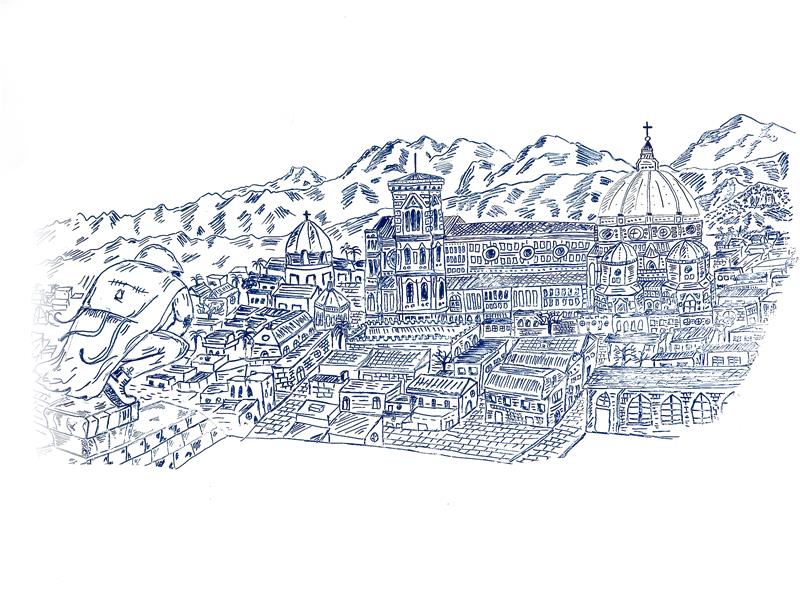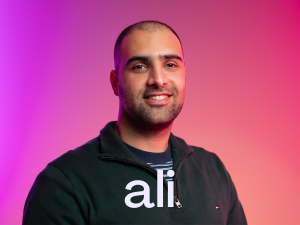‟ When you’re overwhelmed, it’s easy to get fixed on wanting to achieve the perfect research results – but you need to focus on the collaboration, teamwork, and communication that make those results possible.”
Meet Ali Tourani, who travelled from Iran to Luxembourg with a fascinating mission: teaching robots to see the world like we do. When he’s not sketching detailed drawings of Florence to destress and reset his mind, Ali is creating invisible codes that only robots can detect. This robot visualisation innovation means humans can direct and instruct robots without needing to clutter our environments with visual instructions. In this interview, we learn about Ali’s research, his inspiration, and insights into what brings out the best research results.
Relive the conversation – transcript below!
What is your background and why did you come to Luxembourg?
I’m from Rasht in northern Iran. I came to Luxembourg in April 2022, right after the COVID pandemic, to start working as a doctoral researcher. I completed my bachelor’s and master’s degrees in computer software engineering in my hometown. During my master’s studies, I developed software for vehicle speeding violation detection using roadway cameras. Now I’m working with robots, trying to make them more intelligent and aware of their surroundings.
How did you discover your passion for computer vision?
I was always interested in graphics and computer applications like Photoshop and video editing as a teenager. During my bachelor’s studies, I took a course in multimedia applications where the lecturer explained how images are stored and modified in computers. That’s when it clicked – I realised I really loved this field. Since then, I’ve been working in computer vision, which gives computers the ability to understand and interpret visual content like images and videos, just like humans do.
What inspired you to pursue a career in research?
After my master’s, I worked as a web developer for three years. It was rewarding and I made great friends, but after two years, the job became monotonous – repeating the same tasks without understanding the research behind them. I missed the research backbone.
‟ It was a difficult decision to leave a stable career, but now I’m fulfilled because I can apply the teamwork and problem-solving skills I gained in industry to my current research.”
What exactly is your research about?
My PhD focuses on giving robots a better understanding of their surroundings using cameras. You know how QR codes have different patterns that cameras can read? We’re creating a new generation of these codes that robots can see and use for navigation, but these codes won’t need to clutter our own visual environment. It’s like giving robots secret instructions that only they can see.
What’s a common misconception people have about robot vision?
People often ask if robots with cameras can identify different people or objects perfectly. The answer is that many factors can cause these algorithms to fail – different lighting conditions, camera quality, daytime versus nighttime. An algorithm that works fine in daylight might struggle at night. We still have a long way to go before robots can completely understand everything around them.
Who has been your biggest inspiration?
I would choose Steve Jobs. You don’t find many people like him in history. I started reading his biography in 2012, a couple of months after he passed away, and it was very inspiring to learn about his mind as a leader – how he formulated problems, found solutions, and pictured the future. Apart from all his other characteristics, one thing he was exceptionally good at was presentation. He could present new Apple products in a way that everyone could understand, covering technical content so that everyone in the audience could follow.
What do you do to relax and manage the intensity of research?
One solution I discovered is drawing. I spend time sketching to clear my mind and get refreshed for work.
‟ If you step into my office right now, you’ll see a very detailed drawing of the city of Florence on my whiteboard that I’ve been working on. Sketching helps free my mind when I need to reset.”

What’s the most underrated skill in research?
Soft skills are definitely the most underrated. When you get overwhelmed, it’s easy to get preoccupied with wanting to achieve the perfect results and to forget it’s about the collaboration skills – like teamwork and communication, – which lead to those best results. Research shouldn’t be done individually – you need feedback from others to improve your work. You might present to someone from a different field who could apply your ideas to their work. I’ve seen colleagues focus so intensely on their work alone that they realise later they haven’t done good research because they ignored communication and collaboration.
Ali’s research project, TRANSCEND, is supported by the Institute for Advanced Studies (IAS).
